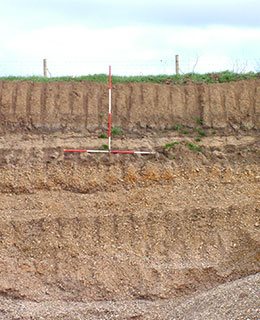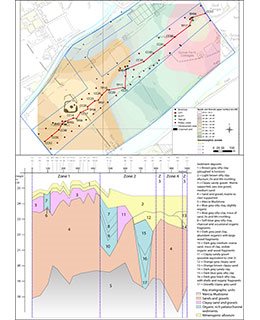This project aims to develop useable and sustainable practices for geoarchaeological deposit modelling within England, which will form a baseline for best practice in both the commercial and academic sectors of applied heritage management. The project is funded by Historic England. Ultimately, this project will aid the development of cost-effective mitigation strategies, especially for development-led archaeology projects.
Archaeological remains are usually stratified within and beneath sedimentary deposits that have accumulated through a combination of anthropogenic and natural processes; deposition can occur over a range of timescales and across numerous geomorphic contexts, often resulting in highly complex, deeply stratified sequences (Figure 1). Understanding the spatial distribution and preservation potential of archaeological remains requires knowledge of the three-dimensional geoarchaeological architecture of sites, which can only be achieved through some form of deposit modelling (Figure 2).
Deposit modelling provides an understanding of site stratigraphy and landscape evolution, and in turn indicates the probable distribution and preservation potential of archaeological remains before costly and intrusive excavations take place. Such knowledge is an essential prerequisite to any project design, informing the scale and type of resources needed. It has the potential to reduce overall costs, both to heritage specialists and developers. Therefore, more widespread and informed use of deposit models will be of benefit to end-users (curators, consultants, archaeological contractors and developers). It will also provide a platform for archaeologists to communicate more effectively at a site level with civil engineers and other construction specialists who use three-dimensional information models as a common currency of project development. Since models are constructed within a digital, highly visual environment, it will also provide the opportunity for heritage specialists to provide their clients with a clearer understanding of the decision-making process that underlies mitigation strategies.
This project collated and critically reviewed a number of approaches to deposit modelling applied by geoarchaeologists working across the commercial and academic archaeological sectors, and produced an edited volume of case studies that will form the basis for best practice guidelines for the historic environment sector in the Historic England guidance series.

Figure 1 – Complex, deeply stratified sequences of deposition

Figure 2 – Deposit modelling